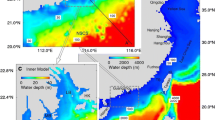Abstract
The formation of the South China Sea (SCS) deep basin warm-core and cool-core eddies was studied numerically using the Princeton Ocean Model (POM) with 20 km horizontal resolution and 23 sigma levels conforming to a realistic bottom topography. Numerical integration was divided into pre-experimental and experimental stages. During the pre-experimental stage, we integrated the POM model for three years from zero velocity and April temperature and salinity climatological fields with climatological monthly mean wind stresses, restoring type surface salt and heat fluxes, and observational oceanic inflow/outflow at the open boundaries. During the experimental stage, we integrated the POM model for another 16 months under three different conditions: one control and two sensitivity runs (no-wind and no lateral transport). We take the fields of the last 12 months for analysis. The simulation under control run agrees well with earlier observational studies on the South China Sea surface thermal variabilities. In addition, the sensitivity study further confirms that the wind effect is the key factor for generation of the SCS deep basin warm/cool eddy and that the lateral boundary forcing is the major factor for the formation of the strong western boundary currents, especially along the southeast Chinese coast during both summer and winter monsoon seasons.
Similar content being viewed by others
References
Blumberg, A. F. and G. L. Mellor (1987): A description of a three-dimensional coastal ocean circulation model. p. 1–16. InThree Dimensional Coastal Ocean Models, ed. by N. S. Heaps, American Geophysical Union.
Cheang, B. K. (1987): Short- and long-range monsoon prediction in southeast Asia. p. 579–606. InMonsoons, ed. by J. S. Fein and P. L. Stephens, John Wiley & Sons Inc., New York.
Chu, P. C. and C. P. Chang (1997): South China Sea warm pool in boreal spring.Adv. Atmos. Sci. 14, 195–206.
Chu, P. C., H. C. Tseng and C. P. Chang (1996): South China Sea warm-core and cold-core eddies detected from the Navy’s Master Oceanographic Observational Data Set. p. 176–180. InProceedings on the Eighth Conference on Air-Sea Interaction, American Meteorological Society.
Chu, P. C., H. C. Tseng, J. M., Chen and C. P. Chang (1997a): South China Sea warm pool detected from the Navy’s Master Oceanographic Observational Data Set.J. Geophys. Res.,102, 15,761–15,771.
Chu, P. C., S. H. Lu and Y. C. Chen (1997b): Temporal and spatial variability of the South China Sea surface temperature anomaly.J. Geophys. Res.,102, 20,937–20,955.
Chu, P. C., C. Fan, C. J. Lozano and J. L. Kerling (1998): An airborne expandable bathythermograph survey of the South China Sea, May 1995.J. Geophys. Res. (in press).
Dale, W. L. (1956): Winds and drift currents in the South China Sea.Malay. J. Trop. Geogr.,8, 1–31.
Haney, R. L. (1971): Surface boundary conditions for ocean circulation models.J. Phys. Oceanogr.,1, 241–248.
Hellerman, S. and M. Rosenstein (1983): Normal monthly wind stress over the world ocean with error estimates.J. Phys. Oceanogr.,13, 1093–1104.
Levitus, S. and T. Boyer (1994): World Ocean Atlas, Vol 4: Temperature.NOAA Atlas NESDIS,4, U.S. Gov. Printing Office, Washington, D.C., 117 pp.
Levitus, S., R. Burgett and T. Boyer (1994): World Ocean Atlas, Vol 3: Salinity.NOAA Atlas NESDIS,3, U.S. Gov. Printing Office, Washington, D.C. 99 pp.
Mellor, G. and T. Yamada (1982): Development of a turbulence closure model for geophysical fluid problems.Rev. Geophys. Space Phys.,20, 851–875.
Metzger, E. J. and H. Hurlburt (1996): Coupled dynamics of the South China Sea, the Sulu Sea, and the Pacific Ocean.J. Geophys. Res.,101, 12,331–12,352.
Nitani, H. (1970): Oceanographic conditions in the sea east of Philippines and Lozon Strait in summer of 1965 and 1966. p. 213–232. InThe Kuroshio—A Symposium on Japan Current, ed. by J. D. Mar, East-West Press, Honolulu.
Smagorinsky, J. (1963): General circulation experiments with the primitive equations.Mon. Wea. Rev.,91, 99–164.
South China Sea Institute of Oceanology, Academia Sinica (1985): p. 183–231. InIntegrated Investigation Report on Sea Area of the South China Sea (II), Science Press, Beijing.
Soong, Y. S., J. H. Hu, C. R. Ho and P. P. Niiler (1995): Cold-core eddy detected in South China Sea.EOS Trans. AGU, 345–347.
Uda, M. and T. Nakao (1972): Water masses and currents in the South China Sea and their seasonal changes. p. 161–188. InThe Kuroshio—Proceedings of the 3rd CSK Symposium, Bangkok, Thailand.
Wyrtki, K. (1961): Scientific results of marine investigations of the South China Sea and the Gulf of Thailand 1959–1961. Naga Report, 2, University of California at San Diego, 195 pp.
Author information
Authors and Affiliations
Rights and permissions
About this article
Cite this article
Chi, P.C., Chen, Y. & Lu, S. Wind-driven South China Sea deep basin warm-core/cool-core eddies. J Oceanogr 54, 347–360 (1998). https://doi.org/10.1007/BF02742619
Received:
Revised:
Accepted:
Issue Date:
DOI: https://doi.org/10.1007/BF02742619



